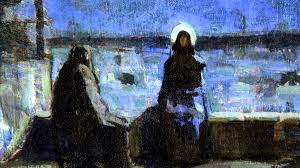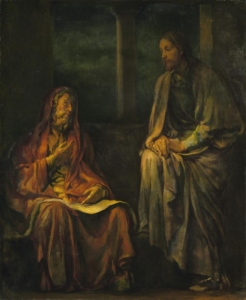March 5, 2023
The Second Sunday in Lent
Click here for previous Sermon Posts
Click here for the Prayers of the People
Weekly Prayer Recording:
How Can These Things Be?
The Reverend Linda Mackie Griggs
Recording of the sermon:
“There was a Pharisee named Nicodemus, a leader of the Jews. He came to Jesus by night…”
John 3:1-18

The writer of John’s Gospel gives us a shady character in Nicodemus; a Pharisee who comes by night, implying that he is either afraid of his colleagues in the Sanhedrin–the council of elders–or ambivalent about following Jesus, or a combination of the two.
Not a flattering portrait. At least, not in this light.
John’s Gospel is all about light, and darkness. It juxtaposes the two as polar opposites, symbolic of good and evil, saved and lost. In reading the story about Nicodemus through this binary lens, we can see what the author wants us to know about him at this point–Nicodemus, the interlocutor in the night. Shady, ambivalent.
Another thing we need to remember about this Gospel is John’s community’s resentment toward the Jewish authorities, particularly the Pharisees, due to the community’s expulsion from the Synagogue in the late first century. This resentment became more pronounced in the later chapters that detail Jesus’ trial and crucifixion. John’s repeated emphasis on “the Jews” as the chief perpetrators of Jesus’ death has been a catalyst for antisemitism for centuries. Understanding the historical context of John’s words is vitally important to counteracting this poisonous misuse of scripture. Words matter.
Back to Nicodemus: When he is identified pejoratively as a Pharisee, as one who approaches Jesus in the darkness as contrasted with daylight, and who seemingly cannot grasp what Jesus tells him about needing to be born from above–or born again–we are not expected to have a high opinion of him. His presence in this story would seem to be simply as a foil for Jesus’ high Christological discourse, which draws our attention heavenward and culminates in arguably the most well-known chapter and verse in the Bible, John 3:16: “For God so loved the world that he gave his only Son, so that everyone who believes in him may not perish but may have eternal life.”
This is the passage and the verse that divide American religious culture into those who identify themselves as “born again” and those who do not. Those who see the John 3:16 signs on televised football games and know exactly what they mean, and those who need to look it up. And generally, where one falls on either side of this divide determines a degree of judgment of one upon the other, doesn’t it? Thus are the Johannine binaries of light and dark, disciple and Pharisee, wise and clueless, saved and perished, lived out in our culture.
How we read the Bible has consequences.
This does not mean that we write off the entire Gospel of John. There is much that is profound, moving, challenging, and inspirational to be found here, and throughout scripture. But uncritical reading of the Bible at best deprives us of a rich and transformational relationship with God’s word, and at worst serves to divide us from one another to a dangerous degree. As the late Rachel Held Evans used to say, the Bible is not a weapon with which we shut down conversation; “God said it, I believe it, that settles it.” Rather it is a Spirit-inspired tool that can open conversation and deepen our relationship with God and the world.
In the Anglican tradition we say that our faith is guided by the so-called “three-legged stool” of Scripture, Reason, and Tradition; that is, our God-given intellect and the writings of theologians and mystics throughout history are the lenses through which we view God’s word. Which is why, in the Book of Common Prayer, our Ash Wednesday liturgy charges us with, among other spiritual disciplines, “reading and meditating on God’s Holy word.” To that end, our Lent Book Group is discussing Evans’ book, Inspired: Slaying Giants, Walking on Water, and Loving the Bible Again, a book that explores broad themes of scripture from the standpoint of one whose relationship with the Bible has evolved from one of uncritical literal interpretation to giving herself permission to question, wrestle, and creatively engage with God’s word. Evans came to understand that the inspiration of scripture doesn’t just come in the writing, but also in the reading; that scripture calls us to be part of a rich and dynamic relationship between the (big C) Creator, the (little c) creator/writer, and the reader.
So, like Rachel Held Evans, let’s give ourselves permission to look again at Nicodemus’ story; this time reading, as I like to say, with question marks; critically, deeply, and imaginatively. Beginning with light and dark.
As I said, John’s Gospel offers us a characteristic binary of light as good and dark as evil. But we know from our own experience that light and dark are not a simple binary. They are related and intertwined, and between them lie the liminal shadows that give life and Creation depth and dimension. Further, our experience of darkness is that it is not always frightening, confusing, and dangerous. Darkness is for rest and sleep. In darkness is where light shines most brightly. Darkness is fertile, where new life germinates.
So, looking again at Nicodemus; is he a shady character, or is he fertile ground for something new to grow? Is he ambivalent about Jesus, or is he deeply drawn to the Light of the World? It may seem like a distinction without a difference, but even a subtle shift in perspective through a more creative reading can reveal the Spirit’s generative movement in the night breeze of our story.
Look again at the relationship between Nicodemus and Jesus, the Pharisee and the troublemaker, as they speak by lamplight. Is their conversation furtive? Antagonistic? Or something else? The Pharisees were deeply faithful practitioners, students and teachers of Torah. Israel’s wellbeing and right relationship with God were their chief priority. They may have been foils for Jesus in the Gospels, but they weren’t stupid. So now picture Nicodemus the Pharisee coming to talk to Jesus in order to argue about theology, as Jewish teachers were wont to do. In that light, their exchange is transformed into two people verbally sparring with one another, teacher to teacher, scholar to scholar. Imagine Nicodemus’ tone as ironic and challenging, rather than naive and clueless, as he throws up his hands in mock frustration: “Can one enter a second time into the mother’s womb and be born?” And then Jesus’ gentle mocking; “Are you a teacher of Israel, and yet you do not understand these things?”
Have we ever considered the possibility that these two men are actually enjoying themselves? What possibilities open up for this story as a result?
What possibilities are opened up if we read not just within but around the passage? Nicodemus appears two more times in this Gospel; when he supports Jesus in a confrontation with the chief priests, risking the ridicule of the Sanhedrin when her reminds them that Jesus had a right to a hearing; and then later when he brings a large quantity of spices for Jesus’ burial. Five pounds of myrrh and aloes was the normal amount for a Jewish burial. This was 75 pounds, fifteen times that amount. Enough to signify the burial of a king. Does this strike us as a person who is ambivalent about Jesus’ identity?
What picture begins to reveal itself as we allow our minds and imaginations to read more deeply and creatively? Can we now see how the Spirit, which “blows where it chooses” may have nudged Nicodemus toward Jesus? Is God birthing something new in him through this conversation, inviting him to transformation? Has the Spirit breathed into him the beginning of a new understanding of how God so loved the world?
Nicodemus asks one final question of Jesus before he disappears from the scene:
“How can these things be?”
Are these the words of a shady interlocutor in the night, deserving of our disdain? Look closer.
Who else in the Bible used almost the same words?
“How can this be?”
Mary, the mother of Our Lord.
“How can these things be?” Nicodemus comes to Jesus in the fertile darkness. The Spirit dances with delight between them as they talk, and nudges Nicodemus toward his own “yes” to God’s new birthing within him.
Is this new birthing possible for us as well?
Look closer. Dig deeper. Engage with the tension. Imagine.
How we read the Bible has consequences.

